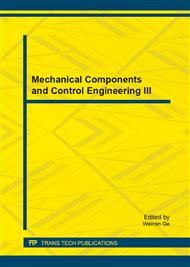p.357
p.361
p.366
p.370
p.374
p.379
p.384
p.388
p.394
Entering Direction Analysis of Matching Area of Underwater Terrain Aided Navigation Based on Variation Function
Abstract:
In order to improve precision of underwater terrain aided navigation and make full use of the features of topographic information, an analysis method is proposed in this paper, in which the variation function is used as the measurement tool. We discuss what to explore relation between variation function and underwater terrain. Through fitting experimental variation function curve, the relationships of different directions of variation function to terrain information capacity are confirmed. Meanwhile, the analysis reveals that the matching area of underwater terrain aided navigation. The experimental results show that variation function reflects the spatial correlation of underwater terrain and the features of terrain. Then, the best entering direction of matching area is found. The certain theory proofs for selection about matching area, study of the terrain adaptation and route planning can be provided.
Info:
Periodical:
Pages:
374-378
Citation:
Online since:
October 2014
Authors:
Price:
Сopyright:
© 2014 Trans Tech Publications Ltd. All Rights Reserved
Share:
Citation:


